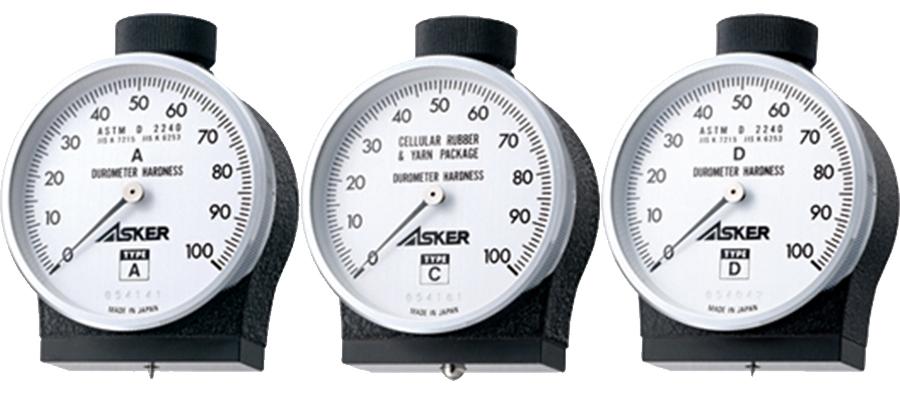LX-A type durometer is used to determine the hardness of vulcanized rubber and similar objects.
LX-D type durometer is used to determine the hardness of rigid plastics (such as thermoplastic plastics, hard resin, nylon, and organic glass), hard rubber and other relevant chemical products.
LX-C type durometer is used to determine the hardness of microporous plastic material made with foaming agent.
Main parameters:
Indenter stroke: 0-2.5mm
Dial value: 0-100 units
Indenter end pressure: 0.55N-8.06N for types A & C; 0-44.5N for type D
How to use:
Put the test block onto a firm surface. Hold the durometer. The indenter at the middle hole of the presser foot should be at least 12mm away from the edges of the test block. Press steadily the presser foot on the test block without any vibration and keep the presser foot parallel to the test block surface so that the indenter presses into the test block vertically. The force applied should be just enough to make the presser foot in complete contact with the test block. Unless otherwise specified, the reading should be taken within 1 second after the complete contact between the presser foot and the test block. In case the reading is taken at another interval, the interval time should be noted down. Measure the hardness 5 times each at a different location with at least 6mm in between, and take the average value.
Notice for use:
(1) Before the test, check that the pointer of the durometer in a free state points to zero. If not, loosen the forcing screw at the top right corner, and turn the face of the meter so that the pointer points to zero. Then press the durometer on a glass pane. When the indenter end face and the presser foot bottom face are in close contact with the glass pane, the pointer should point to 100+/-0.5HA. If not, press the indenter lightly for a few times. If the pointer is still not pointing to 100+/-0.5HA, then the durometer cannot be used in the test.
In case the Shore durometer is used on a test stand, move the handle to lift the workbench till the constant load weight rises, and the indenter end face and the presser foot bottom face are in close contact with the glass workbench, then the pointer should point to 100+/-0.5HA. If not, adjust the adjusting screw on the workbench plane, if after the adjustment the pointer still does not point to 100+/-0.5HA, it is advisable to send the durometer to the manufacturer for adjustment.
(2) Rubber test block and test temperature requirements:
A. The rubber test blocks should be no less than 6 mm thick, 15 mm wide, and 35 mm long. In case the test block is less than 6 mm thick. More layers of the same rubber pieces can be used for testing, however no more than 3 layers. And the top and bottom rubber layers should be parallel to each other;
B. The ambient temperature during the test should be 23℃±5℃, and the durometer should be stored under such temperature for at least one hour before the test.
(3) Plastic test block and test temperature requirements:
A. The plastic test blocks should be square, 50 mm side length and 6 mm thick. Test blocksize 50×15mm are also allowed;
B. Where possible, the test blocks should be adjusted before the test under the standard laboratory temperature according to the provisions of GB/T531.1-2008. The contrast test or serial tests must be performed under the same temperature.
(4) Test block requirement for microporous material: The test blocks should be 10 mm thick. For test blocks less than 10 mm thick, two layers can be used but the contact faces of the two layers must be flat and smooth. The test block size should be such that each test point is no less than 15 mm from the edges of the test block, the distance among the test points are no less than 15 mm, and there are no less than 3 test points on each test block.
(5) The surface of the rubber and plastic test blocks should be smooth and flat, without such defects as mechanical damage, inclusion, and so on. The small lifting shaft on the constant load test stand and the bottom of the workbench should be frequently wiped clean and applied with small amount of anti-rustoil to prevent corrosion.
(6) After the test the durometer should be replaced in the instrument case or instrument container, placed in a dry place, and kept from moisture. The durometer should be sent for calibration at regular intervals according to the provisions. The calibration interval should not exceed one year.
(7) When using a Shore durometer, if the indicating value of type A durometer is lower than 10 HA, the result is inaccurate and cannot be used. In case the measured value by a type A durometer exceeds 90 HA, it is recommended to use type D durometer.

